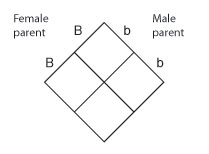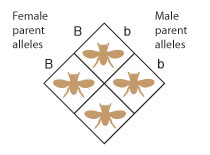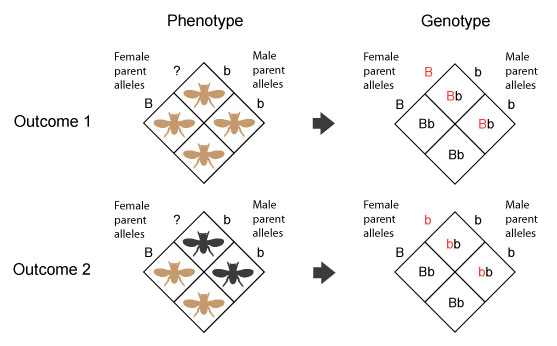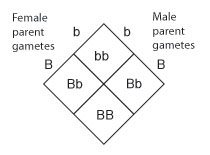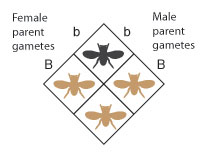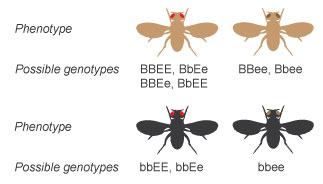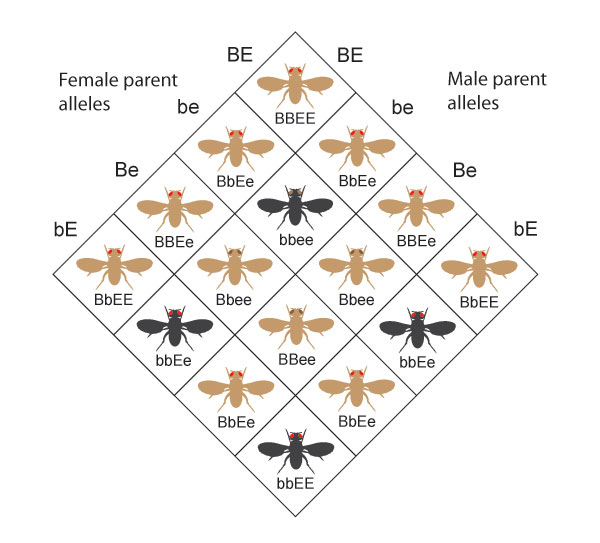« Prev Next »

Inheritance of Traits by Offspring Follows Predictable Rules
Tracing a hidden gene through a family tree
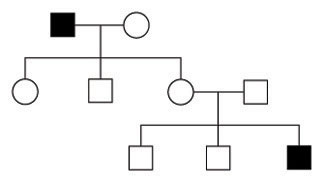
Mendel's principles of inheritance
Gregor Mendel was the first person to describe the manner in which traits are passed on from one generation to the next (and sometimes skip generations). Through his breeding experiments with pea plants, Mendel established three principles of inheritance that described the transmission of genetic traits before genes were even discovered. Mendel's insights greatly expanded scientists' understanding of genetic inheritance, and they also led to the development of new experimental methods.
One of the central conclusions Mendel reached after studying and breeding multiple generations of pea plants was the idea that "[you cannot] draw from the external resemblances [any] conclusions as to [the plants'] internal nature." Today, scientists use the word "phenotype" to refer to what Mendel termed an organism's "external resemblance," and the word "genotype" to refer to what Mendel termed an organism's "internal nature." Thus, to restate Mendel's conclusion in modern terms, an organism's genotype cannot be inferred by simply observing its phenotype. Indeed, Mendel's experiments revealed that phenotypes could be hidden in one generation, only to reemerge in subsequent generations. Mendel thus wondered how organisms preserved the "elementen" (or hereditary material) associated with these traits in the intervening generation, when the traits were hidden from view.
How do hidden genes pass from one generation to the next?
The relationship of alleles to phenotype: an example
Relationships between dominant and recessive phenotypes can be observed with breeding experiments. Gregor Mendel bred generations of pea plants, and as a result of his experiments, he was able to propose the idea of allelic gene forms. Modern scientists use organisms that have faster breeding times than the pea plant, such as the fruit fly (Drosophila melanogaster). Thus, Mendel's primary discoveries will be described in terms of this modern experimental choice for the remainder of this discussion.

In fruit flies, the gene for body color has two different alleles: the black allele and the brown allele. Moreover, brown body color is the dominant phenotype, and black body color is the recessive phenotype.
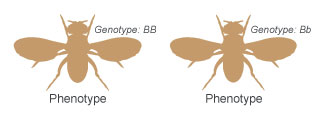
Dominance, breeding experiments, and Punnett squares
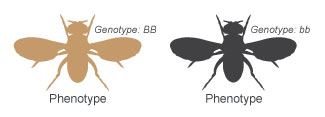
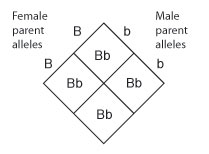
This outcome shows that the brown allele (B) and its associated phenotype are dominant to the black allele (b) and its associated phenotype. Even though all of the offspring have brown body color, they are heterozygous for the black allele.
How can a breeding experiment be used to discover a genotype?
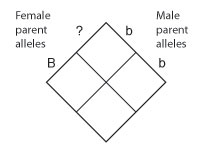
A test cross is a breeding experiment in which an organism with an unknown genotype associated with the dominant phenotype is mated to an organism that is homozygous for the recessive phenotype. The Punnett square in Figure 8 can be used to consider how the identity of the unknown allele is determined in a test cross.
Again, the Punnett squares in this example function like a genetic multiplication table, and there is a specific reason why squares such as these work. During meiosis, chromosome pairs are split apart and distributed into cells called gametes. Each gamete contains a single copy of every chromosome, and each chromosome contains one allele for every gene. Therefore, each allele for a given gene is packaged into a separate gamete. For example, a fly with the genotype Bb will produce two types of gametes: B and b. In comparison, a fly with the genotype BB will only produce B gametes, and a fly with the genotype bb will only produce b gametes.
Can two different genes be examined at the same time?
The principle of segregation explains how individual alleles are separated among chromosomes. But is it possible to consider how two different genes, each with different allelic forms, are inherited at the same time? For example, can the alleles for the body color gene (brown and black) be mixed and matched in different combinations with the alleles for the eye color gene (red and brown)?
The simple answer to this question is yes. When chromosome pairs randomly align along the metaphase plate during meiosis I, each member of the chromosome pair contains one allele for every gene. Each gamete will receive one copy of each chromosome and one allele for every gene. When the individual chromosomes are distributed into gametes, the alleles of the different genes they carry are mixed and matched with respect to one another.
In this example, there are two different alleles for the eye color gene: the E allele for red eye color, and the e allele for brown eye color. The red (E) phenotype is dominant to the brown (e) phenotype, so heterozygous flies with the genotype Ee will have red eyes.
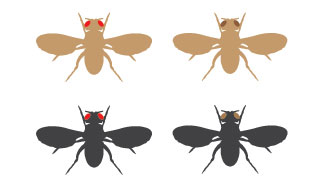
The dihybrid cross: charting two different traits in a single breeding experiment
Consider a cross between two parents that are heterozygous for both body color and eye color (BbEe x BbEe). This type of experiment is known as a dihybrid cross. All possible genotypes and associated phenotypes in this kind of cross are shown in Figure 14.
The four possible phenotypes from this cross occur in the proportions 9:3:3:1. Specifically, this cross yields the following:
- 9 flies with brown bodies and red eyes
- 3 flies with brown bodies and brown eyes
- 3 flies with black bodies and red eyes
- 1 fly with a black body and brown eyes
Why does this ratio of phenotypes occur? To answer this question, it is necessary to consider the proportions of the individual alleles involved in the cross. The ratio of brown-bodied flies to black-bodied flies is 3:1, and the ratio of red-eyed flies to brown-eyed flies is also 3:1. This means that the outcomes of body color and eye color traits appear as if they were derived from two parallel monohybrid crosses. In other words, even though alleles of two different genes were involved in this cross, these alleles behaved as if they had segregated independently.
The outcome of a dihybrid cross illustrates the third and final principle of inheritance, the principal of independent assortment, which states that the alleles for one gene segregate into gametes independently of the alleles for other genes. To restate this principle using the example above, all alleles assort in the same manner whether they code for body color alone, eye color alone, or both body color and eye color in the same cross.
The impact of Mendel's principles
Mendel's principles can be used to understand how genes and their alleles are passed down from one generation to the next. When visualized with a Punnett square, these principles can predict the potential combinations of offspring from two parents of known genotype, or infer an unknown parental genotype from tallying the resultant offspring.
An important question still remains: Do all organisms pass on their genes in this way? The answer to this question is no, but many organisms do exhibit simple inheritance patterns similar to those of fruit flies and Mendel's peas. These principles form a model against which different inheritance patterns can be compared, and this model provide researchers with a way to analyze deviations from Mendelian principles.
Further Exploration
Key Questions
eBooks
This page appears in the following eBook




